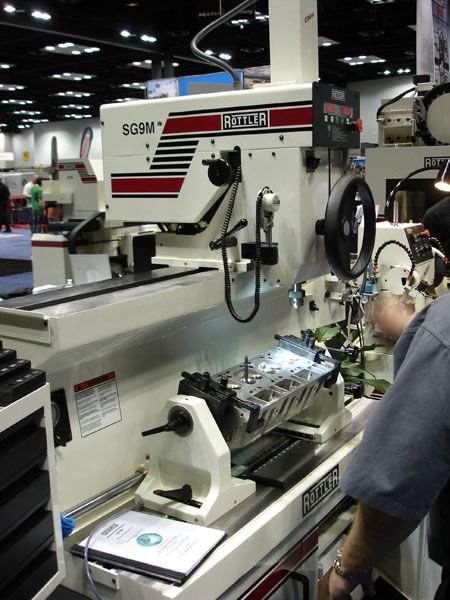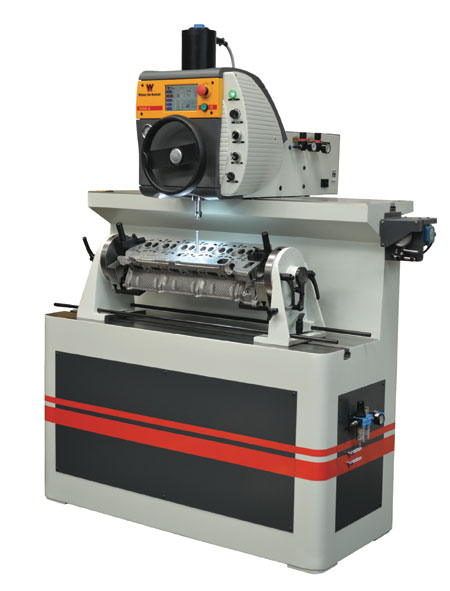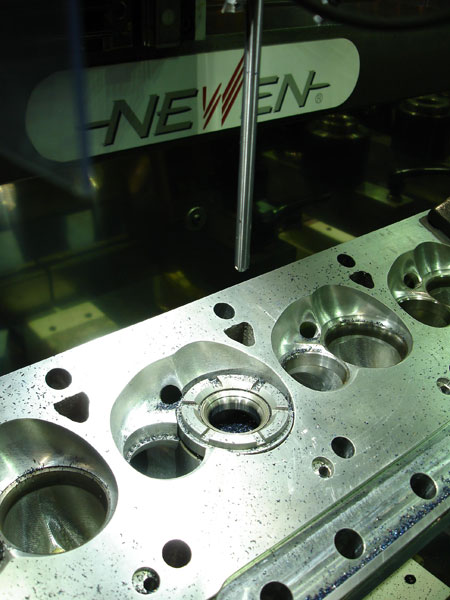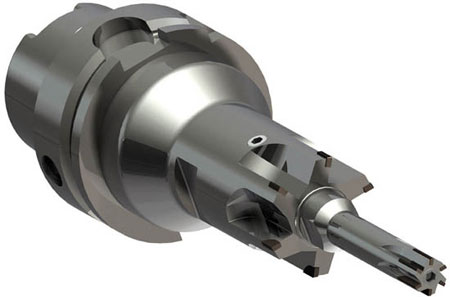A valve seat and guide machine is an essential piece of equipment for any shop that does cylinder head work. So whether you are thinking about upgrading your existing equipment, buying a brand new machine or finding a good used machine, there are a number of important factors to consider as you make your decision.
One of the most important features almost every equipment supplier we contacted for this article emphasized is versatility. What are the capabilities of the machine? Can it handle longer or wider cylinder heads? Does the machine have enough vertical travel and fore and aft travel to do what you want it to do? Is a dedicated valve guide and seat machine all you need for head work or would a multi-purpose machining center provide additional capabilities that would better serve your needs?
Most of the newer machines have a floating head that makes head repositioning fast and easy. A tilting head allows you to align the spindle with the guide in the cylinder head rather than having to align the head to the spindle. An older used machine with a fixed head can’t provide that kind of versatility. It’s the same story for the fixturing. Can the fixturing handle the kind of heads that you work on most? If not, what will it cost to replace or upgrade the fixturing so it can handle such heads?
Guide and seat machines have evolved over the years. Constant refinements have been made to improve speed, accuracy, flexibility, ease of setup and operation. Some of the newer machines are available with digital or computer numeric controls (CNC). Maybe you don’t think you need such bells and whistles on a valve guide and seat machine. But once you make the transition from manual equipment to digital or automated equipment, there’s no going back.
Accuracy
Accuracy is absolutely essential regardless of the brand, other features or age of the equipment. Valve seat to guide concentricity is the number one criteria for any valve guide and seat machine. Many factors can affect concentricity and accuracy. Most experts recommend using dead pilots (fixed pilots) rather than live pilots. Live pilots leave room between the pilot shaft and the inside diameter of the valve guide so they can spin freely. Even if that is only .0001?, it still adds up to .0001? on each side of the shaft. Depending on the length and size of the pilot, that may allow as much as 0.001? of tolerance runout at the valve seat.
Too much runout in the seat will cause a valve to flex every time it closes, and over time this can lead to valve fatigue and possible valve failure. The most accurate method for making sure the valve seat is concentric with the guide is to use a concentricity gauge. A simple vacuum check can be misleading because a valve can still seat even if the seat is slightly off-center with respect to the centerline of the guide.
Fixed pilots have a gradual taper that centers off the middle of the valve guide (which is important when you are working on heads with high mileage valve guides that are typically worn at the top and bottom). The other benefit of fixed pilots is that you don’t have to have as many sizes, so your investment in pilots can be 30% lower than if you were using a live pilot system. Whether you choose to use fixed or live pilots, you should always use carbide pilots.
Other factors that affect accuracy include the type of seat material you are cutting, the rpms of the machine and the sharpness of your cutter blades. Seat concentricity can also be affected by how the spindle is driven. Some machines have belts that connect the main spindle quill to a motor in the back of the machine. This may cause vibration which translates into runout that affects the concentricity of the valve seats.
For machines that do have the motor mounted directly on the quill, it is important to have adequate power since torque affects performance. If a machine lacks sufficient power to cut a seat properly, you get chatter. Always look at the type of motor (bearing motors vs. servo-motors that have higher vibration frequency), and compare the power rating of the motor.
Probably one of the most overlooked aspects of achieving the best valve seat concentricity is leveling. Many people are using bubble levels, or simple 1-axis digital levels. The problem with the bubble level is that there is no way to get the accuracy needed. With a simple 1-axis level, the reading is not taken at the spindle quill but from a post on the side of the machine. To align the post to the quill, you must put an adapter in the quill, test it, then test the post.
But there’s no guarantee the alignment will remain the same. If you accidentally hit the post too hard, or didn’t tighten it down enough, you can move your “0” on the level. As a result, your post will not be aligned properly with the quill. If you then level your valve guide to the “0” on the post, the valve guide and spindle quill will not be aligned. The most accurate approach is to consistently check the location of the quill directly so you know it is lined up with the valve guide.
The rigidity of the machine is also important. The more rigid the equipment, the better it can hold accurate alignment and resist vibration. Consider the strength of the base casting, column and head stands. Can it withstand an earthquake or will it quiver and shake with every tremor?
Something else you may not know is that valve guide and seat machines built for the U.S. market are not the same as those that are built for the European market. In Europe all of the guides and seats are replaceable so the only machining operation is to profile the seats and occasionally counterbore for oversize seats.
In the U.S., we do the same kind of jobs but also reclaim spring pockets, drill for replacement guides, drill out broken studs and re-thread the holes, counterbore the castings for seat inserts, replace spark-plug threads, drill for screw-in studs and guide plates and then profile the seats to perfect geometry as well. So the machine has to have the power and versatility to handle all of these jobs well.
Speed
Speed is important, but not at the cost of accuracy. Since dead pilot systems are capable of producing higher tolerances, using a dead pilot system is preferable to a live pilot system even if it is somewhat slower. There are new tools on machines like “spring-less ball heads” that allow the worker to move from one guide to the next without having pull off all the previous tooling. It makes the work faster and easier on the operator without sacrificing accuracy.
Of course, the most accurate valve guide an seat machine in the world won’t do much to boost your productivity and profitability if it is a pain to set up and use. That’s why equipment suppliers have continued to refine and improve the setup and operation of their machines so they are quick and easy to use. Mounting a cylinder head in a cradle is fairly simple on most machines today.
Automated digital or CNC controls now make it possible for almost anybody to operate a valve guide and seat machine. With a manual machine, the operator has to mechanically move the quill down. No matter how good the machinist is, it is nearly impossible to be absolutely consistent with every repetition that they do. On top of that, some machinists are more skilled than others. You have good, better, and best employees. With an automated valve guide and seat machine, the variability and inconsistencies between employees is eliminated. You get consistent high quality results no matter who is operating the machine.
What About Maintenance And Service?
Something else to think about is the amount of maintenance a machine may require over time, and the level of service the equipment supplier can provide when you need it. Service after the sale is something you may not think is all that important – until you need it. Most shops can’t afford to have a critical piece of equipment out of commission because they can’t get parts or service on a timely basis.
One of the big disadvantages of buying older used equipment is that replacement parts may be difficult to find – especially if the equipment supplier has gone out of business or no longer makes valve guide and seat machines. So the savings on the price of the equipment may not seem like such a bargain after all if you discover the machine was worn parts that need to be replaced and you can’t get the parts you need.
If you want to know how good a machine really is or what kind of customer service you can expect when the need arises, talk to someone who is using similar equipment. Your equipment salesman should be able to provide you with some reference contacts in your area you can call for more details. Do call them and ask them if they are satisfied with their equipment, if they have run into any problems with it, and if so how the equipment company handled it. A red flag before the sale is better than an unpleasant surprise after a sale.
Other Considerations
A list of other things you should consider when looking at valve guide and seat machines includes the following:
• Tooling storage;
• Tooling capabilities of the machine;
• Ease of changing tooling;
• Ease of setting up and cutting a seat;
• Tool sharpener for tooling;
• Vacuum for keeping working area clean;
• Front-to-back and side-to-side travel of the work head;
• Work lighting (This one can’t be stressed enough!);
• Air float of machine work head (Ease of floating and locking);
• Make sure head can tilt +/- 15 Deg for canted valve guide work;
• Ease and accuracy of leveling;
• Built in vacuum tester (To test your work before you take it off the machine);
• Motor RPM variation; and
• Motor power, motor type, motor location.
Notice that we did not mention cost yet as a consideration. That’s because the cost of the equipment should be the LAST thing you look at when choosing a new piece of equipment. Don’t let the high cost of some machines scare you off. Yes, everybody has to operate within a budget, and no piece of equipment is worth the price if it can’t pay for itself one way or another.
Your investment should deliver a higher level of quality, allow you to work on a wider variety of heads or to do jobs your current machine can’t do, and it should give you a measurable improvement in productivity and profitability.
The price of the equipment doesn’t always reflect the true capabilities of the equipment, but as a rule you should expect to pay more for digital or CNC controls, additional features and tooling. Many equipment suppliers offer a variety of models and options, and can often customize a machine to match your specific requirements and finances. Communication is important here to make sure that what you are buying is what you actually need and that you fully understand the capabilities of the equipment.



















